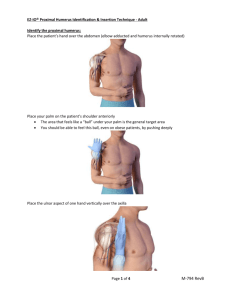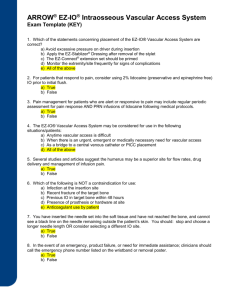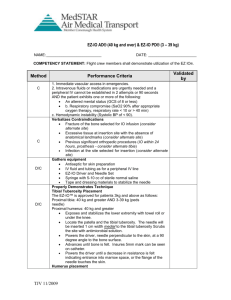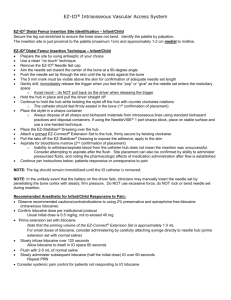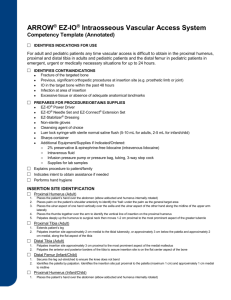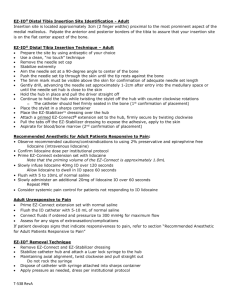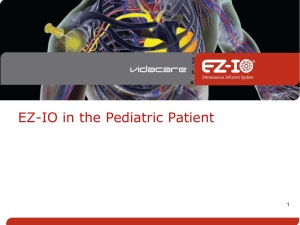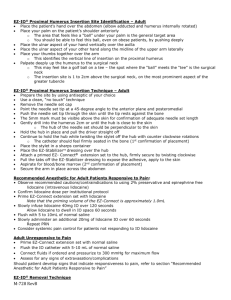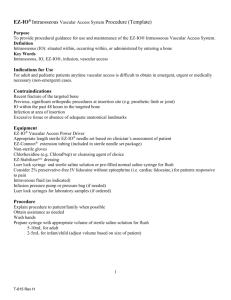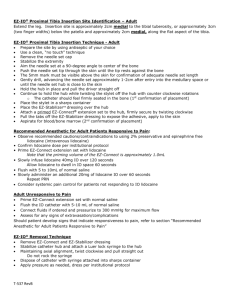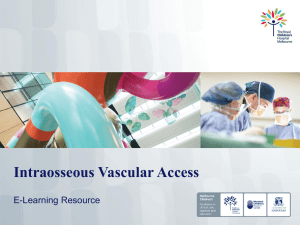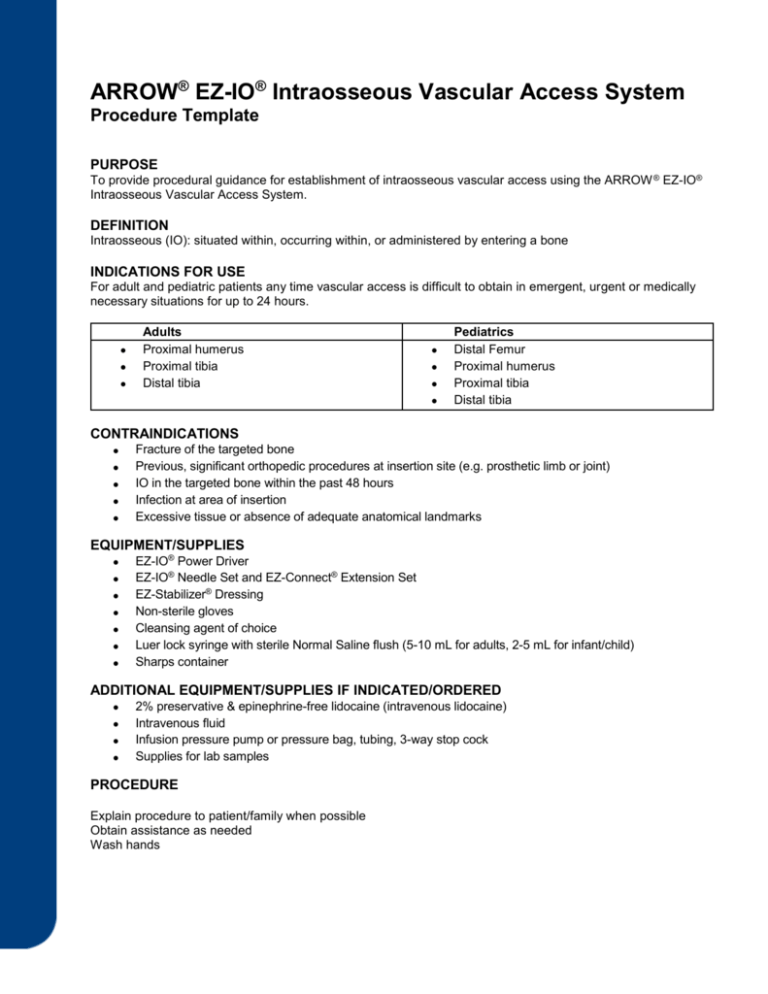
ARROW® EZ-IO® Intraosseous Vascular Access System
Procedure Template
PURPOSE
To provide procedural guidance for establishment of intraosseous vascular access using the ARROW ® EZ-IO®
Intraosseous Vascular Access System.
DEFINITION
Intraosseous (IO): situated within, occurring within, or administered by entering a bone
INDICATIONS FOR USE
For adult and pediatric patients any time vascular access is difficult to obtain in emergent, urgent or medically
necessary situations for up to 24 hours.
Adults
Proximal humerus
Proximal tibia
Distal tibia
Pediatrics
Distal Femur
Proximal humerus
Proximal tibia
Distal tibia
CONTRAINDICATIONS
Fracture of the targeted bone
Previous, significant orthopedic procedures at insertion site (e.g. prosthetic limb or joint)
IO in the targeted bone within the past 48 hours
Infection at area of insertion
Excessive tissue or absence of adequate anatomical landmarks
EQUIPMENT/SUPPLIES
EZ-IO® Power Driver
EZ-IO® Needle Set and EZ-Connect® Extension Set
EZ-Stabilizer® Dressing
Non-sterile gloves
Cleansing agent of choice
Luer lock syringe with sterile Normal Saline flush (5-10 mL for adults, 2-5 mL for infant/child)
Sharps container
ADDITIONAL EQUIPMENT/SUPPLIES IF INDICATED/ORDERED
2% preservative & epinephrine-free lidocaine (intravenous lidocaine)
Intravenous fluid
Infusion pressure pump or pressure bag, tubing, 3-way stop cock
Supplies for lab samples
PROCEDURE
Explain procedure to patient/family when possible
Obtain assistance as needed
Wash hands
INSERTION SITE IDENTIFICATION
Palpate site to locate appropriate anatomical landmarks for needle set placement and to estimate soft tissue
depth overlying the insertion site. Utilize the correct technique below based on patient and site selected:
ADULT INSERTION SITE IDENTIFICATION
Proximal Humerus (Adult)
1. Place the patient’s hand over the abdomen (elbow adducted and humerus internally rotated)
2. Place your palm on the patient’s shoulder anteriorly; the “ball” under your palm is the general target area
You should be able to feel this ball, even on obese patients, by pushing deeply
3. Place the ulnar aspect of your hand vertically over the axilla and the ulnar aspect of your other hand along the
midline of the upper arm laterally
4. Place your thumbs together over the arm; this identifies the vertical line of insertion on the proximal humerus
5. Palpate deeply up the humerus to the surgical neck
This may feel like a golf ball on a tee – the spot where the “ball” meets the “tee” is the surgical neck
The insertion site is 1 to 2 cm above the surgical neck, on the most prominent aspect of the greater
tubercle
Proximal Tibia (Adult)
1. Extend the leg.
2. Insertion site is approximately 2 cm medial to the tibial tuberosity, or approximately 3 cm below the patella and
approximately 2 cm medial, along the flat aspect of the tibia.
Distal Tibia (Adult)
1. Insertion site is located approximately 3 cm proximal to the most prominent aspect of the medial malleolus.
2. Palpate the anterior and posterior borders of the tibia to assure insertion site is on the flat center aspect of the
bone.
INFANT/CHILD INSERTION SITE IDENTIFICATION
Distal Femur (Infant/Child)
1. Secure the leg out-stretched to ensure the knee does not bend.
2. Identify the patella by palpation. The insertion site is just proximal to the patella (maximum 1 cm) and
approximately 1-2 cm medial to midline.
Proximal Humerus (Infant/Child)
1. Place the patient’s hand over the abdomen (elbow adducted and humerus internally rotated)
2. Place your palm on the patient’s shoulder anteriorly; the “ball” under your palm is the general target area
You should be able to feel this ball, even on obese patients, by pushing deeply
3. Place the ulnar aspect of your hand vertically over the axilla and the ulnar aspect of your other hand along the
midline of the upper arm laterally
4. Place your thumbs together over the arm
This identifies the vertical line of insertion on the proximal humerus
5. Palpate deeply up the humerus to the surgical neck
This may feel like a golf ball on a tee – the spot where the “ball” meets the “tee” is the surgical neck
The insertion site is 1 to 2 cm above the surgical neck, on the most prominent aspect of the greater
tubercle
Proximal Tibia (Infant/Child)
1. Extend the leg. Pinch the tibia between your fingers to identify the medial and lateral borders.
2. Insertion site is approximately 1 cm medial to the tibial tuberosity, or just below the patella (approximately 1
cm) and slightly medial (approximately 1 cm), along the flat aspect of the tibia.
Distal Tibia (Infant/Child)
1. Insertion site is located approximately 1-2 cm proximal to the most prominent aspect of the medial malleolus.
2. Palpate the anterior and posterior borders of the tibia to assure insertion site is on the flat center aspect of the
bone.
NEEDLE SET SELECTION
Select EZ-IO® Needle Set based on patient weight, anatomy and clinical judgment. The EZ-IO® Catheter is
marked with a black line 5 mm proximal to the hub. Prior to drilling, with the EZ-IO® Needle Set inserted through
the soft tissue and the needle tip touching bone, adequate needle length is determined by the ability to see the 5
mm black line above the skin.
EZ-IO® 45 mm Needle Set (yellow hub) should be considered for proximal humerus insertion in patients 40
kg and greater and patients with excessive tissue over any insertion site
EZ-IO® 25 mm Needle Set (blue hub) should be considered for patients 3 kg and greater
EZ-IO® 15 mm Needle Set (pink hub) should be considered for patients approximately 3-39 kg
INSERTION
Use a clean, “no touch” technique, maintaining asepsis
Prepare supplies
Prepare the site by using antiseptic of your choice; stabilize the extremity
Remove the needle set cap
ADULT INSERTION TECHNIQUE
Proximal Humerus - Adult
1. Aim the needle set at a 45-degree angle to the anterior plane and posteromedial
2. Push the needle set tip through the skin until the tip rests against the bone
The 5 mm mark must be visible above the skin for confirmation of adequate needle set length
3. Gently drill into the humerus approximately 2 cm or until the hub is close to the skin; the hub of the needle set
should be perpendicular to the skin
Tibia - Adult
1. Aim the needle set at a 90-degree angle to the bone
2. Push the needle set tip through the skin until the tip rests against the bone
The 5 mm mark must be visible above the skin for confirmation of adequate needle set length
3. Gently drill, advancing the needle set approximately 1-2 cm after entry into the medullary space or until the
needle set hub is close to the skin
INFANT/CHILD INSERTION TECHNIQUE
Proximal Humerus – Infant/Child
1. Aim the needle set tip at a 45-degree angle to the anterior plane and posteromedial
2. Push the needle set tip through the skin until the tip rests against the bone
The 5 mm mark must be visible above the skin for confirmation of adequate needle set length
3. Gently drill, immediately release the trigger when you feel the loss of resistance as the needle set enters the
medullary space; avoid recoil – do NOT pull back on the driver when releasing the trigger
Femur and Tibia – Infant/Child
1. Aim the needle set at a 90-degree angle to the bone
2. Push the needle set tip through the skin until the tip rests against the bone
The 5 mm mark must be visible above the skin for confirmation of adequate needle set length
3. Gently drill, immediately release the trigger when you feel the loss of resistance as the needle set enters the
medullary space; avoid recoil – do NOT pull back on the driver when releasing the trigger
INSERTION COMPLETION
1. Hold the hub in place and pull the driver straight off; continue to hold the hub while twisting the stylet off the
hub with counter clockwise rotations; catheter should feel firmly seated in the bone (1st confirmation of
placement);
Dispose of all sharps and biohazard materials using standard biohazard practices and disposal
containers.
If using the NeedleVISE® 1 port sharps block, place on stable surface and use a one-handed technique.
2. Place the EZ-Stabilizer® Dressing over the hub
3. Attach a primed extension set to the catheter hub, firmly secure by twisting clockwise
4. Pull the tabs off the dressing to expose the adhesive, apply to the skin
5. Aspirate for blood/bone marrow (2nd confirmation of placement)*
*Inability to withdraw/aspirate blood from the catheter hub does not mean the insertion was unsuccessful.
6. Proceed with technique below, based on situation:
A. ADULT - RESPONSIVE TO PAIN – RECOMMENDED ANESTHETIC
Observe recommended cautions/contraindications to using 2% preservative and epinephrine-free
lidocaine (intravenous lidocaine) and confirm lidocaine dose per institutional protocol
1. Prime extension set with lidocaine
Note that the priming volume of the EZ-Connect® Extension Set is approximately 1.0 mL
2. Slowly infuse lidocaine 40 mg IO over 120 seconds
3. Allow lidocaine to dwell in IO space 60 seconds
4. Flush with 5 to 10 mL of normal saline
5. Slowly administer an additional 20 mg of lidocaine IO over 60 seconds.
Repeat PRN; consider systemic pain control for patients not responding to IO lidocaine
B. ADULT - UNRESPONSIVE TO PAIN
1. Prime extension set with normal saline
2. Flush the IO catheter with 5-10 mL of normal saline
If patient develops signs indicating responsiveness to pain, refer to adult recommended anesthetic
technique.
C. INFANT/CHILD - RESPONSIVE TO PAIN – RECOMMENDED ANESTHETIC
Observe recommended cautions/contraindications to using 2% preservative and epinephrine-free
lidocaine (intravenous lidocaine) and confirm lidocaine dose per institutional protocol; usual initial dose
is 0.5 mg/kg, not to exceed 40 mg
1. Prime extension set with lidocaine; priming volume of the EZ-Connect® Extension Set is approximately
1.0 mL
For small doses of lidocaine, consider administering by carefully attaching syringe directly to
needle hub (prime extension set with normal saline)
2. Slowly infuse lidocaine over 120 seconds
3. Allow lidocaine to dwell in IO space 60 seconds
4. Flush with 2-5 mL of normal saline
5. Slowly administer subsequent lidocaine (half the initial dose) IO over 60 seconds.
Repeat PRN; consider systemic pain control for patients not responding to IO lidocaine
D. INFANT/CHILD - UNRESPONSIVE TO PAIN
1. Prime extension set with normal saline
2. Flush the IO catheter with 2-5 mL of normal saline
If patient develops signs indicating responsiveness to pain, refer to infant/child recommended anesthetic
technique.
7. Connect fluids if ordered and pressurize up to 300 mmHg for maximum flow
8. Verify placement/patency prior to all infusions. Use caution when infusing hypertonic solutions,
chemotherapeutic agents, or vesicant drugs.
9. Stabilize and monitor site and limb for extravasation or other complications
For proximal humerus insertions, apply arm immobilizer or other securement device
For distal femur insertions, maintain securement of the leg to ensure the knee does not bend
10. Document date and time on wristband and place on patient
REMOVAL TECHNIQUE
1. Remove extension set and dressing
2. Stabilize catheter hub and attach a Luer lock syringe to the hub
3. Maintaining axial alignment, twist clockwise and pull straight out
Do not rock the syringe
4. Dispose of catheter with syringe attached into sharps container
5. Apply pressure to site as needed to control bleeding and apply dressing as indicated
The use of any medication, including lidocaine, given IV or IO is the responsibility of the treating physician, medical director
or qualified prescriber and not an official recommendation of Teleflex Incorporated or its subsidiaries. Teleflex is not the
manufacturer of lidocaine, and the user should be familiar with the manufacturer’s instructions or directions for use for all
indications, side-effects, contraindications, precautions and warnings of lidocaine. Teleflex disclaims all liability for the use,
application or interpretation of the use of this information in the medical treatment of any patient. Lidocaine dosing
recommendations were developed based on research; for additional information, please visit www.eziocomfort.com
This material is not intended to replace standard clinical education and training by Teleflex Incorporated and its subsidiaries
and should be utilized as an adjunct to more detailed information which is available about the proper use of the product.
View educational resources at www.teleflex.com/ezioeducation or contact a Teleflex clinical professional for any detailed
questions related to product insertion, maintenance, removal and other clinical education information.
Teleflex, Arrow, EZ-Connect , EZ-IO, and EZ-Stabilizer are trademarks or registered trademarks of
Teleflex Incorporated or its affiliates.
© 2014 Teleflex Incorporated. All rights reserved. MC-000270

